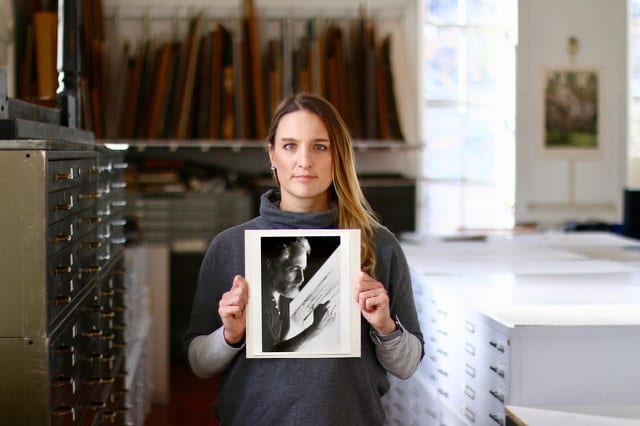
no description

no description
The late Harold Altman was a world-renowned artist whose work appears in New York’s Museum of Modern Art, the Victoria and Albert Museum of London, the Bibliotheque Nationale of Paris, and elsewhere. Altman spent many years in Happy Valley, capturing rural scenes of Mount Nittany and the surrounding countryside.
With his death in 2003, Altman left behind an enormous collection of work (some 500,000 pieces), the organization, marketing, and sale of which has been turned over to his daughter, Jessie Beers-Altman.
Beers-Altman, a documentary filmmaker, has, until recently, resided in Boston with her family. Over the past two summers, she and her husband returned to Lemont, where she grew up, to sort through her father’s estate. They’ve now made the decision to move back to the area.
“We were very naïve about what we were getting into,” says Beers-Altman. “We filled up eight commercial dumpsters – not with artwork, but with 50 years’ worth of accumulation – documents and furniture and art supplies, all sorts of things.”
Altman’s former studio – located in a converted blue church on Mount Nittany Road (not currently open to the public) – is now cleaned up, organized, and inventoried. Next up: selling the art.
“It’s been almost 20 years since anyone really marketed the art to sell it,” says Beers-Altman. “We’re faced with this new art environment of trying to figure out how to get the art back out there.”
Beers-Altman was finding success building and re-establishing relationships with galleries when the COVID-19 pandemic hit. Now, she and her husband are working on growing an e-commerce presence.
‘Little miracles everywhere’
Altman moved to the Centre County region to teach at Penn State in the 1960s. Though his daughter says her dad “always considered himself a New Yorker,” she says he “really loved the small-town feel of State College, combined with all that came here because of the university. He liked the cultured feeling of the town, but he was also really drawn to the natural beauty of the region.”
Altman was prolific, producing hundreds of thousands of works of art through painting, drawing, lithography, and etching. Beers-Altman says after her father had finished a set of prints, he would move on, and rarely would he return to promote past pieces.
“What I’m excited about is to showcase and promote some of his earlier work,” says Beers-Altman. “I am personally drawn to some of his more abstract and linear etchings that he did in the 1960s. Those are the kinds of pieces that really put him on the map in the art world.”
Beers-Altman says her father’s lithographs are now among his most recognizable works (she’s spotted them in TV shows and movies), but the early etchings “haven’t been promoted in 50 or 60 years.”
Beers-Altman remembers her father as a person who was a little “eccentric” in his interpretation of beauty.
“The way my dad looked at the world – he could see something beautiful or marvelous or interesting in the strangest of places,” she recalls. “For instance, he found a bar of soap that was in the bathroom in the studio that mice had gnawed at – they carved a pattern into it. He found it so fascinating that he kept it on his desk and would show it to people and say, ‘The mice are artists, too!’ It sounds kind of bizarre, but that’s how he was. He would constantly be recognizing little miracles everywhere.”
‘I feel his presence’
Exploring his studio as an adult, Beers-Altman says she has come to know and appreciate her late father in a different light.
“I always knew he was a talented artist, but I had no idea how hard he worked at that,” she says. “In the studio is evidence of so much rejection before he found his success. … I had no idea how much of a businessman he was. He really worked to get his work out there.”
In the days before email, Altman would cold-call people and send them letters to promote his art. Beers-Altman came across a letter her father had sent Jackie Kennedy, along with a print.
“She ended up keeping the print, and I found a letter back from her saying ‘Thank you for this print, it’s lovely, it’s beautiful,’ all that,” says Beers-Altman. “[This project has] really been a way to get to know [my father] much better. I feel that I feel his presence and that I’m understanding more about who he was.”
Sparking a new project
Beers-Altman says she’s learned a lot not just about her father, but about the history of her family and the world that influenced her dad while he was alive. She’s been inspired to create a project of her own and has been working on a long-term documentary film project about her experience with the working title of Inherited.
“[The film was] originally about my dad’s life and career, but it’s turned into this idea of legacy and how we interpret legacy and how it can be a positive thing or a negative thing,” Beers-Altman says.
For more information about Altman and to purchase his art, visit haroldaltman.com.
Teresa Mull is a freelance writer in Philipsburg.
Receive all the latest news and events right to your inbox.

80% of consumers turn to directories with reviews to find a local business.